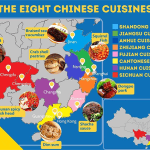Chinese Food
China’s extensive history, vast territory, and rich culture have given rise to the unique art of Chinese cuisine. Through thousands of years of innovation and refinement, Chinese cuisine has gained popularity among a growing number of international food enthusiasts.
Ranked among the top three cuisines globally, alongside French and Turkish cuisine, Chinese cuisine holds a significant influence in East Asia. With origins in various regions and ethnic groups within China, Chinese cuisine can be categorized into the Eight Famous Cuisines, local snacks, ethnic dishes, and more. Deeply rooted in traditional Chinese philosophy, Chinese food embodies the harmony and balance of nature, not only satisfying the palate but also promoting overall health and well-being.
Popular Chinese Cuisines & Foods
For many foreign travelers, Chinese cuisine is often associated with dishes like Sichuan Hot Pot, Peking Roast Duck, Kung Pao Chicken, and Sweet and Sour Pork. While these dishes are indeed delicious and popular in China, the world of Chinese cuisine extends far beyond these well-known favorites.
With its vast territory and abundant resources, China has developed a diverse culinary landscape influenced by different regions, climates, and ingredients. Chinese cuisine can be categorized by region, with over a dozen regional cuisines and the most renowned being the Eight Famous Cuisines. In addition to regional cuisines, ethnic foods such as Tibetan and minority cuisine offer unique flavors and characteristics. Local snacks, while not considered formal meals, hold a special place in the hearts of many.
Cities like Chengdu and Xi’an are famous for their snacks, attracting travelers who come specifically to sample these local delights. The variety and complexity of Chinese cuisine reflect the rich cultural heritage and culinary traditions of this vast and diverse country.
Eight Famous Cuisines
There are eight famous cuisines, each divided according to region and flavors. These include Lu Cuisine (Shandong Cuisine), Chuan Cuisine (Sichuan Cuisine), Yue Cuisine (Guangdong Cuisine), Min Cuisine (Fujian Cuisine), Su Cuisine (Jiangsu Cuisine), Zhe Cuisine (Zhejiang Cuisine), Xiang Cuisine (Hunan Cuisine), and Hui Cuisine (Anhui Cuisine).
Ethnic Food
Ethnic regions in China, such as Tibet, Yunnan, Guizhou, Xinjiang, and Inner Mongolia, boast unique food cultures. The cuisines in these areas are intricately developed based on the rich tapestry of ethnic traditions, local customs, and regional specialties. While some travelers are enamored by these culinary delights, others may not find them to their taste. It is important to be prepared for this diversity of flavors before embarking on a journey to these regions.
Local Snacks
Local snacks play an important role in Chinese food culture. Every region has its own unique featured snacks, with major food hubs like Beijing, Chengdu, Xian, Guangzhou, and Shanghai offering a wide variety of local delicacies. These cities are also home to bustling snack streets, where food enthusiasts can indulge in a plethora of culinary delights all in one convenient location.
Top 10 Chinese Dishes among Travelers
Many foreigners have already experienced Chinese cuisine before visiting China. The top 10 most popular Chinese dishes among foreigners include Sweet and Sour Pork, Kung Pao Chicken, Spring Rolls, Fried Rice, Mapo Tofu, Jiaozi, Wonton, Roast Duck, Chow Mein, and Sautéed Shrimp with Cashew Nuts.
Chinese Food Culture
With a history spanning over five thousand years, China’s food culture is a vital component of its rich heritage. Deeply rooted in traditional Chinese philosophy, such as Yin-Yang, Five Elements, and Confucianism, Chinese cuisine and its culinary practices embody the principles of harmony and balance found in nature. Guided by Traditional Chinese Medicine, Chinese cuisine aims to promote health and even treat illnesses by carefully combining various ingredients.
Referred to as the “state of ceremonies,” dining etiquette holds significant importance in Chinese food culture. Understanding and adhering to Chinese etiquette not only demonstrates one’s respect and refinement but also helps avoid unintentionally offending your Chinese host.
Throughout the centuries, nearly a hundred cooking techniques have been developed within Chinese food culture. These diverse methods not only showcase the ingenuity of the Chinese people but also contribute to the wide array of flavors found in Chinese cuisine.

























